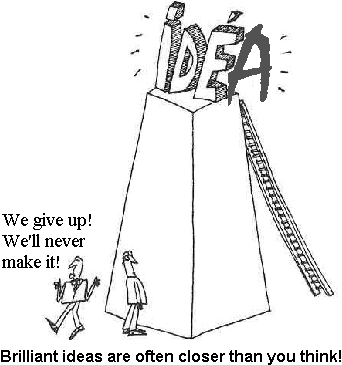
creative problem solving assignment

Explain the practical application of Total Systems Intervention Approach by applying it in a business situation. Also discuss the strengths and weaknesses of Total Systems Approach.
acknowledgements
I would like to thank Dr. Kaup Mohammed, my course leader for Creative Problem Solving for his continuing interest, encouragement, and support in helping me complete this assignment.
We are all influenced by the thoughts and ideas of other people which tend to drift into the subconscious and are not always distinguished clearly from one’s own. I have attempted to give references for sources of work by other writers but apologise to any concerned if acknowledgement has inadvertently not been recorded.
contents
I. Acknowledgements
II. List of Figures
III. Abstract
IV. Introduction
V. Total Systems Intervention
VI. System of Systems Methodologies
VII. Principles of TSI
VIII. TSI operates in three modes
IX. Soft Systems Methodology
A. Stage 1 and 2 - Finding out
B. Stage 3 - Formulating root definition
C. Stage 4 - Building conceptual model
D. Stage 5 - Comparing models with reality
E. Stage 6 - Defining changes
F. Stage 7 - Taking action
X. Viable Systems Methodology
A. System 1 - Implementation
B. System 2 - Co-ordination
C. System 3 - Control
D. System 4 - Intelligence gathering
E. System 5 - Policy
XI. Strength of TSI
XII. Weaknesses of TSI
XIII. Conclusion
XIV. Bibliography
XV. Appendix
list of figures
1. A grouping of systems methodologies.
2. A comparison of simple and complex systems.
3. The process of TSI.
4. The process of soft systems methodology.
5. The rich picture of Fashion Fabrics Ltd.
6. The leadership styles at Fashion Fabrics Ltd.
7. The conceptual model of the leadership style.
8. Comparison of reality with the conceptual model.
abstract
It has been the tendency of human beings, from time memorial, to solve problem situations by dividing them into smaller, manageable parts. This reductionist approach has on the one hand prevented us from seeing the ‘whole picture’ and on the other hand has clogged our creativity. Various mental locks, such as, find the right answer, that’s not logical, follow the rules, be practical, don’t be foolish, that’s not my area or I’m not creative actually prevent us from being creative or ‘thinking what nobody has thought’.
Total Systems Intervention or TSI, however, offers a creative and holistic problem solving approach which enriches the way organisations perceive the diversity and complexity of the problems they face. The philosophy of TSI is expressed by Critical Systems Thinking which emphasises complementarism, sociological awareness and human well-being and emancipation. TSI offers a range of methodologies which can be chosen through the System of Systems Methodologies (SOSM). TSI incorporates a three stage ‘meta-methodology’ which cannot be carried out in isolation and must be embarked upon with others in view.
The practical use of TSI in understanding organisations and their problem situations has been analysed by applying it in a real life organisational situation. Further the results of the application of the Soft Systems Methodology has been analysed complementarily with the use of Viable Systems Methodology.
TSI as a ‘holistic problem solving approach’ offers an invaluable aid to practising managers but it’s diversity and universal application are not free from certain weaknesses. Nevertheless, it still is and shall remain a guiding framework for future mangers when facing the complexities of the new millennium.
The lowest form of thinking is the bare recognition of the object. The highest , the comprehensive intuition of the man who sees all things as part of a system. – Plato
Introduction
In the modern, dynamic world we are all faced with a plethora of multifaceted difficulties and problems. A problem is any situation for which we need new ideas or plans. It is the gap between where we are and where we want to be. The technological upheavals and cultural revolutions have imposed new adaptations on the society, widening the gap between the perception of the global problems and formulation of their solutions. Such sets of interacting problems and messes call for a new approach to problem-solving. “Various systems designed to help management make decisions have had a great deal of time and effort spent on them , yet have been of little help.” (Finlay, P., 1994, p1) . A gap had long been existing for a holistic approach which effectively addresses the issues of social interactions in organisations. This gap has been filled by Total Systems Intervention (TSI).
Total Systems Intervention
TSI is a problem solving approach that uses insights from the totality of systems and management sciences to address organisational messes in a holistic manner. TSI is a ‘meta-methodology’ founded on the philosophy of Critical Systems Thinking (CST), which advocates the informed and complementary use of all systems theories, concepts and methodologies This is facilitated by the inclusion of critical awareness, social awareness and human emancipation as the fundamental principles of CST. Thus TSI recognises:
· the complementarism of the various problem-solving methods,
· the organisational and social constraints in the implementation of the various methods, and
· the need to fully develop the potential of all individuals, working in organisations and in society.
System of Systems Methodology
Inorder to use TSI “a problem-solver must understand the entire organisation in systemic terms, which can only be achieved by developing a whole systems view of the organisation in focus” (Flood, 1995). To do this, four key organisational dimensions must be understood:
Processes – the various inflows and outflows of information or matters in the system as well as the feedback loops.
Design – the formal and informal structures and functions, co-ordination and control.
Culture – values, beliefs, norms, underlying assumptions or simply "the way things are done"
Politics – the power structure of the different stakeholders.
These dimensions can be then used to select and match the methodology to the problem situation through the System of System Methodologies.(SOSM ). SOSM provides a grid of problem contexts based on the nature of the system and the nature of the participants involved.
A comparison of simple and complex systems can be seen in the table below:

Participants defined as unitary have common interests and beliefs and decisions are taken in a participative manner.
Pluralist do not necessarily share similar values, but their basic interests are the same and atleast temporarily agree on objectives.
Participants defined as coercive have no common interests and hold conflicting values. Hence joint decision making is not possible.
Principles of TSI
TSI aims at aiding intervention in the real world by guiding managers in the selection of the best systems methodology for their particular problems. The principles of TSI are:
· Organisations and their problems are too complicated to be solved with a universal, ‘quick-fix’ method.
· Organisational difficulties can be investigated using a range of ‘systemic metaphors.’
· Systems metaphors can be linked to systems methodologies to guide intervention..
· Different metaphors and methodologies can be used complementarily to address different aspects of the organisation’s problems.
· TSI sets out with the principle of ‘iteration’.
· The clients, owners and the actors in the system are engaged at all stages of the TSI process.
TSI operates in three modes:
1. Critical Review,
2. Problem Solving and
3. Critical Reflection
The Critical Review Mode reviews critically all methods that can be used for solving a problem, while the Problem Solving Mode focuses on thinking creatively about the problem situation, identifying and selecting key challenges and using the most suitable method(s) to solve it. Finally, the Critical Reflection Mode reflects upon the results of the Problem Solving Mode.
The TSI methodology, as outlined above, can be used for understanding organisations and their complexities, and to initiate changes. This shall be considered by applying TSI in a real life case study. (See appendix for the case.)
I. Creativity: Though various systemic metaphors can be identified as operating at different levels and departments of the organisation, in its current state the culture metaphor dominates at Fashion Fabrics.
II. Choice : Soft Systems Methodology was the chosen methodology because the study of the organisation required consideration of both the cultural issues and the organisational structure and processes. Moreover the mess that the founder faces is complex and soft and given these circumstances , SSM was the obvious choice.
III. Implementation: The various stages of SSM are analysed below
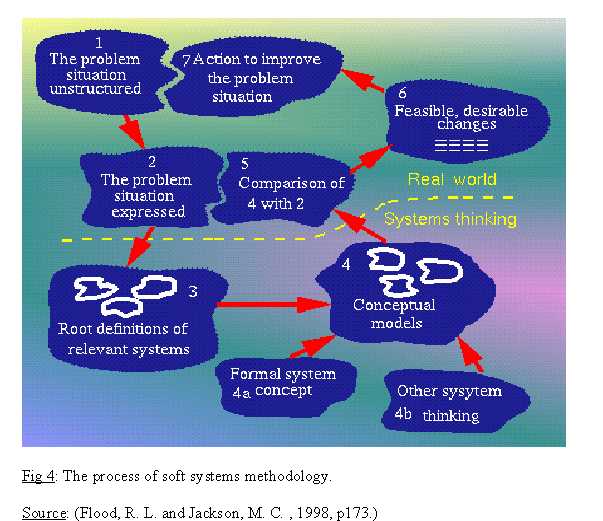
Stage 1 and 2 - Finding out:
Stages 1 and 2 are concerned with constructing the rich picture { See page 6(a)}. From the rich picture various problems could be detected. The absence of proper motivation schemes, lack of cordial working environment was causing conflict and confusion. Furthermore, with the increase in competitive pressures a well defined structure for ‘responsibility with reward’ ; and training arrangements had to be made, but there were hardly any provisions for these It was also necessary to provide a ‘participative management’ to ensure the success of any action aimed at addressing the above issues.
Stage 3 - Formulating root definition:
Stage three is concerned with building various themes and formulating a root definition. “ The aim is to draw out the essence of what is to be done, why it is to be done, who is to do it, who is to benefit/ suffer from it and what environmental constraints limit the action and activities. This is achieved by formulating the statement around six elements.” (Flood, R. L. and Jackson, M.C., 1998, p175).
The various themes that can be used to address the various issues being faced by Fashion Fabrics are:
1) A communication system seeking to encourage open dialogue and removal of grievances.
2) A motivation system aimed at meeting employee’s monetary and non-monetary needs and retaining their services.
3) A control system aimed at minimising errors and delays and promoting efficiency in dealing with customers.
4) A participative system for appraisals, providing adequate training, and defining responsibility which in turn can be linked to the motivation system.
The root definition that was chosen, however , was the system of leadership which, through a consultative and democratic approach, tries to increase the organisation’s efficiency by continuously meeting the needs of the employees and aiming at their overall development. To ensure a well formulated root definition, all elements of CATWOE were considered:
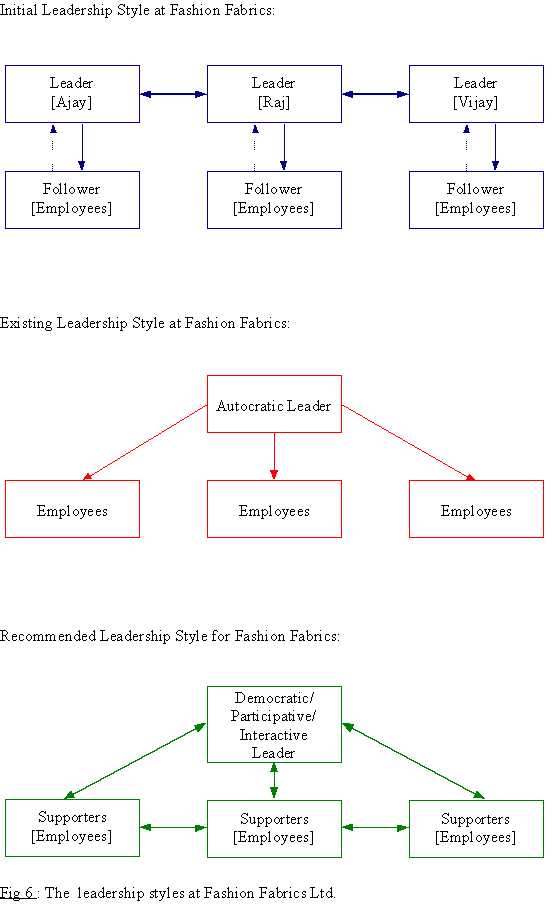
1) Customers: Raj Bhatia (the founder), the employees, the organisation’s clients.
2) Actors: The management, the employees.
3) Transformation Process: Open communication lines, continuous appraisal and training, 360 degree appraisal, participative policy making.
4) Weltanschauung: Recognition of employees as ‘true value creators’; stakeholders favouring democratic structures and perceived as beneficial by customers too.
5) Owners: The founder , the employees.
6) Environmental Constraints: Competitor activity to attract employees and customers, government labour regulations, increasing costs of doing business, market demand and the corporate culture.
Stage 4 - Building conceptual models:
“A conceptual model is constructed by drawing out the minimum number of verbs that are necessary to describe the activities that would have to be present to carry out the task named in the root definition”. (Flood, R.L. and Jackson. M.C., 1998, p176). Various sub-systems can also be arranged, in a logical manner, which are concerned with the operation of the system as a whole.
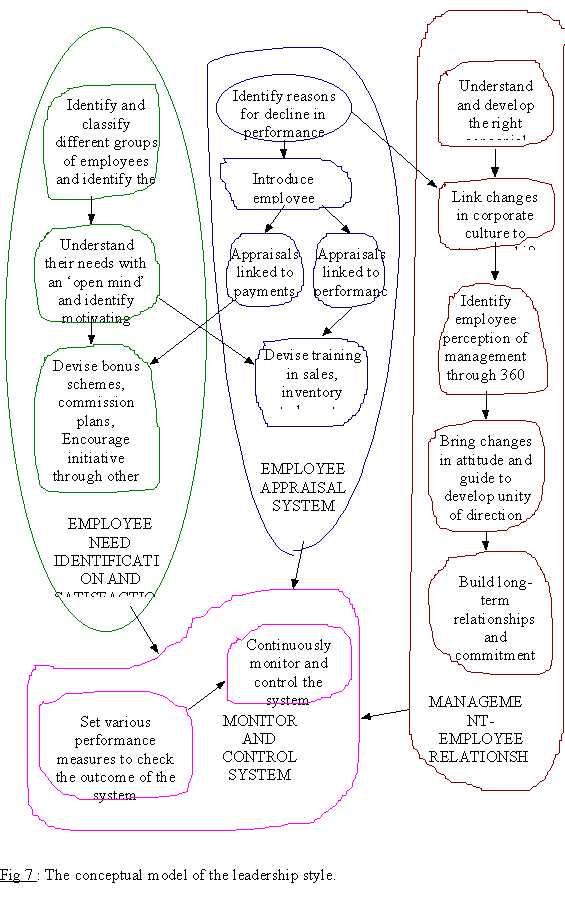 .
.
Stage 5 - Comparing models and reality:
Having built the conceptual model it is necessary to compare the list of activities with those already existing in the present. This process helps to highlight the likely changes that would have to be made to bring ‘reality’ closer to the ‘ideal holistic conceptual model’. A comparison of the conceptual model and reality of Fashion Fabrics is shown below:
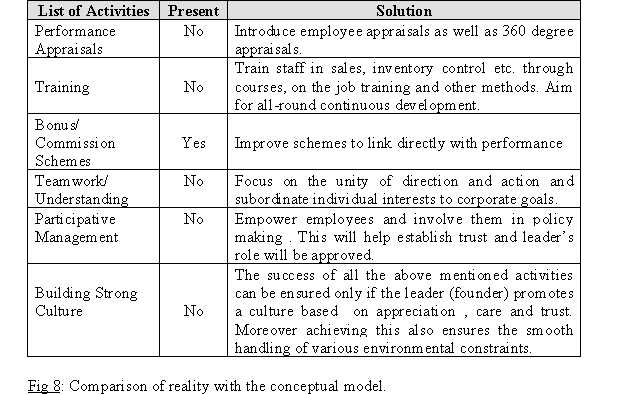
Stage 6 - Defining changes:
Having built the systemic desirable models, one also has to consider various possible changes. In the case of Fashion Fabrics , for example, the change in the management style i.e. towards a participative management may be achieved, but it is the building of a strong culture that is more difficult to achieve. The corporate culture has not developed overnight. First the founder brought in his ideas to the enterprise, there were initially shared by his brothers , and together they formed a core group. Later, however, the founder’s assumptions and beliefs modified with changes in the environment. To bring about changes for the better , the founder has to accept the detrimental impact of the present culture on the business. Systematic changes that are both desirable and feasible have to be gradually introduced to develop new assumptions about the business, it’s environment, it’s people and their experiences.
Stage 7 - Taking action:
Finally various changes, attitudinal, structural and procedural, have to be implemented.
Structural changes may be to reporting structures, performance appraisals, reward schemes, participative decision making etc.
Procedural changes may be to the process of appraisals (group, individual; formal, informal), the incentives for motivation, reporting procedures (verbal, written), process of training etc.
Attitudinal changes are intangible but are very important in bringing changes in the expectations which employees have of the above changes. The structural and procedural changes can in-turn act as a symbolic activity to bring attitudinal changes. Attitudinal changes should be monitored continuously as they occur steadily through shared experiences
Viable Systems Methodology (VSM)
Having considered the various stages of the SSM, the ideas can be further developed through the use of the viable systems method. The philosophy that drives the VSM are the modern complexities (organisational, technological, informational, etc.) that mangers have to face. This has led to the need for a well tried and tested ‘control system’ that is efficient and effective and at the same time continuously evolves itself. VSM is based on the principle of cybernetics where emphasis is laid on recursion, localised sources of command and control, learning relationship with the environment and on other cybernetics principles that are all guided by a ‘meta-system’.
VSM’s arrangement of the five functional elements as existing in the present scenario at Fashion Fabrics is analysed below. Recommendations for each of the five systems are also given.
System 1- Implementation:
This system is concerned with the components or departments in the organisation, their autonomy and their association with the local environment. The various components existing at Fashion Fabrics include purchase, stock control, sales, finance, organising etc. All these functions are under the direct supervision and control of the founder and departments enjoy little autonomy. Though these parts have complex interactions with the environment their perceptibility and permeability to changes leave a lot to be desired.
Recommendations: The founder should delegate tasks to the employees and appoint functional heads giving them equal authority and responsibility, with flexibility in the day-to-day operations. Based on a ‘learning culture’ importance could be attached to continuous improvements and a ‘learning approach to strategy’ can be developed.
System 2- Co-ordination:
This system is concerned with the harmonious co-ordination between the various components and the removal of friction through a co-ordinating body/ person/ arbiter. At Fashion Fabrics the frustrated, de-motivated employees have little co-ordination. The founder, due to his autocratic style, has been unable to maintain harmonious relationship. This instability has also led to regular errors and delays.
Recommendations: Identify employee needs and promote relationships based on trust. Make everyone’s job and authority clear but emphasise on ‘enabling structures’ that go beyond the ‘written contract’. Run a ‘consciousness-raising development programme’ through a joint employee and management initiative, based on democratic lines.
System 3 - Control:
This system interprets the policy decisions and maintains internal stability through regular audits. The control by the founder of Fashion Fabrics has been based on doubt and lack of trust. Decisions are being imposed and no attention is paid towards employee problems, motivation, appraisals, customer satisfaction, declining sales etc.
Recommendations: Bring out the hidden, unrecognised needs and assumptions of the employees. At the same time build an ethos of self-responsibility, with a development of systems that encourage individuals and components to act as a small business within a wider, controlled environment. Through discussions in spirit of overall win:win ensure that all internal units facilitate ‘internal exchange’ and aim at delighting one another.
System 4 - Intelligence gathering:
This system deals with the collection of information about a firm’s total environment and reporting it. The overlooking of the changing government regulations, increased competition, declining disposable incomes and other macro and micro factors point to the absence of such a system at Fashion Fabrics
Recommendations: Develop a ‘system of informating’ whereby the boundary workers can serve as environmental scanners and collect information from customers, suppliers, community etc. Employees may also be encouraged to take responsibility for their own learning and development through mutual guidance, developmental groups one-to-one coaching, co-counselling etc.
System 5 - Policy:
This system assesses the policy formulation and arbitration between the antagonistic demands on the organisation. The policy development at Fashion Fabrics is highly autocratic, employees are ‘made to dance at the founder’s tunes’ and differing views are not even considered, leave alone arbitration.
Recommendations: A participative policy making system can be developed where there is a deliberate fostering, encouragement and recognition of contributors. Contribution can be sought from employees, customers, suppliers, owners, community and the macro environment in general. Conflicts can be minimised by focusing on the commonality of objectives that each stakeholder wants to achieve. Moreover the diversity and complexity of ideas will also ensure creativity .
Strengths of TSI
TSI helps managers and decision makers apply their own innovative potential to transform ‘blue-sky’ ideas into practical solutions for complex, high-value business problems. As a result, unexpected insights and new applications for ideas emerge.
Participants learn how to examine problems from new perspectives, developing ‘creative paradigms’ and novel solutions to achieve real change and improvement. TSI can show how various elements in the environment are categorised and evaluated. This can help mangers in identifying bottlenecks in the system.
Through the use of TSI mangers can clarify their company vision, and show their subordinates how to use that vision to develop a strategic plan. Mangers can help specify the content and process of strategy changes over time, by comparisons with other stakeholder’s opinions.
TSI with its emphasis on relationships among concepts and people has the potential of capturing the co-ordination of action that is crucial to the implementation of strategy.
The use of TSI from the industry’s perspective and level of detail can help mangers evaluate the commonly held causal assumptions and can help generate alternative assumptions that would lead to a competitive advantage.
TSI creates a setting in which the group enhances the uniqueness and creativity of every member. Participants (superiors as well as subordinates) become more co-operative during implementation as the problems were actually ‘perceived’ by them and the proposals ‘developed’ with them. Moreover discussions prior to considering alternatives can actually make problem solving less complicated and successful results are more likely to be achieved.
Another primary benefit of using this process, in a work group or organisation, is that it allows individuals within the group to understand the problem thoroughly before considering alternatives
TSI helps identify weaknesses in sub-systems, and it allows managers to relate the parts or functions of every sub-system to each other and to the whole. This in-effect achieves synergy and efficiency which further enhances the development of unity within the organisation and the energy of all the participants becomes more focused.
Weaknesses of TSI
TSI offers a range of metaphors and systems methodologies, and their right use requires the familiarity with all of these. The real world problems may also not fit exactly in any one ‘box’ of the system of systems methodology. Moreover the absence of a methodology for dealing with ‘complex-coercive’ situation poses further difficulties.
TSI, by offering a broad-structured and clear guidance clogs creativity and dictates personal biases. “It is open to criticism that it will likely be applied in a functionalist ‘recipe-like’ mode in practice.” (Ragsdell, G., 1998, p59).
Managers also have to decide upon the purpose TSI will serve and the territory it will cover. Subsequent decisions include the specific source of information, it’s reliability as well as it’s validity. Decisions about the choice of the appropriate methodology may also require ‘trade-offs’ which must be weighed carefully.
Though individuals learn to value alternative viewpoints due to the natural tendency of individuals to consider their own approaches as more correct than other’s , the use of participative processes can lead to conflicts.
Another important issue that managers must pay attention to in using TSI in their organisations is the characteristics and personality types of their co-managers, superiors as well as their subordinates. Though all the members may advocate the use of TSI unanimously, the manner in which they perceive the benefits of implementing the techniques will depend to a great extent on their nature and nurture.
TSI may be used to come to conclusions in an ad-hoc manner and then dress them up as derived from the application of systems methodology. Moreover, interactively generating directly relevant data from individuals may lead to overly rational solutions without any significant creative insights.
A solution may also be selected on some other criteria than ‘does it solve the problem’ where one alternative is presented, and everyone simply agrees that it is best without critical analysis. “This can lead the organisation to make decisions based on power relationships (the boss likes this one), on affiliations (George is my friend, so I'll support him), or on some basis other than achievement of goals.” (Kolstoe, 1985).
Finally, it is difficult to actually put into practice the complex underlying philosophy of Critical Systems Thinking and requires a lot of time too.
Conclusion
Thus we can see that TSI brings together a huge effort in the area of management sciences and human values. Though it does have some weaknesses, they are trivial compared to TSI’s strengths. More importantly it cuts through the boundaries of an orthodox, reductionist approach to guide towards a more creative, holistic problem solving approach. All aspects of the total business- the people, their processes, physical assets as well as the internal and external publics will be integrated by modern management far beyond today’s primitive levels. “Perhaps the future managers will put it this way- the synergistic relationship of business and society will be optimised through a sophisticated total systems approach.” (Murdick, R.G., 1994, p16). The true challenge for TSI, however, lies in its test as a system to deal with novel problems that future mangers will face in the new millennium.
BIBLIOGRAPHY
1. Bonham, G.M. and Shapiro, M.J., (19760: “Explanation of the unexpected; the Syrian intervention in Jordan in 1970”, in Axelrod, K. (eds.).” The Structure of Decision”, pp 113-141, Princeton, NJ : Princeton University Press.
2. Bougon, M; Weick, K and Binkhorst, D. (1997): “Cognition in organisations: an analysis of the Utrecht Jazz Orchestra”. “Administrative Science Quarterly”, 22, 606-639.
3. Bransford, J., & Stein, B. (1984): “The ideal problem solver”. New York: W. H. Freeman.
4. Checkland, P. (1995): “Systems Thinking, Systems Practice” : John Wiley and Sons.
5. Dewey, J. (1933): “How we think”. New York: “Heath”. (Originally published in 1910).
6. Eden, C; William, H and Smithin, T. (1985): “Synthetic Wisdom- designing a united mode modelling system for organisational decision making”.. “Working Paper OIM/84, University of Bath”, England.
7. Gagne, R. (1974): “Essentials of learning from instruction”. Hinsdale, IL: Dryden.
8. Gagne, R. (1984): “Learning outcomes and their effects”. American Psychologist, 39, 377-385.
9. Huff, A.S. (1994): “Mapping Strategic Thought” : John Wiley and Sons Ltd.
10. Huitt, W. (1992): “Problem solving and decision making: Consideration of individual differences using the Myers-Briggs Type Indicator”. “Journal of Psychological Type”, 24, 33-44.
11. Finegan, A (1994) : “Soft Systems Methodology: An Alternative Approach to Knowledge Elicitation in Complex and Poorly Defined Systems”, RMIT Centre for Remote Sensing, Australia.
12. Flood, R.L. and Jackson, M.C. (1998): “Creative Problem Solving- Total Systems Intervention.” : John Wiley and Sons.
13. Flood R.L. and Romm N. (1994) : “Enhancing the Process of Choice in TSI and Improving Chances of Tackling Coercion” : University of Hull, UK.
14. Flood, R.L. (1995) : “Solving Problem Solving, a Potent Force for Effective Management”: John Wiley & Sons, Chichester.
15. Ford, J. and Hegonty, H. (1984): “Decision makers beliefs about the causes and effects of structure : an exploratory study”. “Academy of Management Journal”, 27, 271-291.
16. Jackson, M.C. (1991) : “Systems Methodology for The Management Sciences” : Plenum, New York.
17. Kadiri, Y (1997): “Lecture Notes for Creative Problem Solving Module of Hull MBA”: University of Hull, UK.
18. Kolstoe, J. (1985) : “Consultation”. Oxford: George Ronald Press.
19. Mintzberg, H. (1975): “The Manger’s Job: folklore and fact”, “Harvard Business Review”, July-August, pp 49-61.
20. Murdick, G.; Ross, J.E. and Claggett, J.R. (1994): “Information Systems and Modern Management” (3rd Ed.); Prentice Hall India.
21. Oech, R. V. (1995): “Unlock your own creativity”, in Khanna, R.K.; Kaushik, S.L. and Sinha, K. K. (eds.): “English for students of commerce”: Oxford University Press, New Delhi, pp.22-28.
22. Polya, G. (1971): “How to solve it”. Princeton, NJ: Princeton University Press. (Originally published in 1957).
23. Ragsdell, G. (1998): “Creative Problem Solving -The Primer” : ULH Publications
24. Schwenk, C.R. (1985): “The use of participant recollection in the modelling of organisational decision processes”. “Academy of Management Review”, 10, 496-503.
25. Stewart, R. (1967): “Managers and their Jobs”: MacMillan, London.
26. Treffinger, I. and Dorval (1994): “Creative Problem Solving- An Introduction”: Sarasota, F.L: Centre for Creative Learning.
27. Whimbey, A., & Lochhead, J. (1982): “Problem solving and comprehension” (3rd ed.): Franklin Institute Press. Philadelphia
28. <URL:http://www.valdosta.edu.html>
29. <URL:http://www.sfc.keio.ac.jp.html>
30. <URL:http://www.gwu.edu.edu.html>
Appendix
TSI in Action: A Case Study
Fashion Fabrics Ltd. is a small firm, based in Sharjah, UAE, dealing in retail textiles. It was started in the year 1975 by Raj Bhatia, who had earlier been in Muscat, Oman where he worked as a sales executive for five years. Within the first year of operation, Ajay and Vijay, Raj’s younger brothers also joined the business.
During the early 1980s there was little competition in the retail textile market. Business grew continuously at a steady rate and customers weren’t hard to find. It was during these exciting years that the three brothers built a significant capital investment. Soon they set-up two more branches within the emirates. The three brothers’ reputation grew rapidly and along with it grew the size of their earnings.
In the year 1992, however, things began to change. Due to personal conflicts (arising because of organisational difficulties and differences) and other family commitments, both Ajay and Vijay left the business. This led to significant work load on the founder’s shoulders, which in turn led to a considerable change in his attitude towards his employees and his business. The style of his management became autocratic and he strictly exercised a greater, closer control over the staff and the office activities. Soon a general frustration set in the minds of the employees. Efficiency declined, sales decreased and a number of loyal customers started switching due to delays and errors. Conflicts between the founder and employees started taking place and many employees started leaving the organisation in search of better opportunities.
Combined with the above mentioned problems were the other macro environmental factors that started affecting the growth and profitability of the business. By 1995 there was intense competition in the industry, real disposable incomes of the consumers had declined, overheads increased significantly and government regulations on business had become severe. The problems came to their extreme point when in October 1996 the government of UAE decided to regularise the labour market. This made it legally impossible for Fashion Fabrics to recruit new or part-time employees. Owing to organisational difficulties the founder ultimately decided to shut down one of its branches in November 1998.
Today the organisation is merely existing in chaotic conditions. Errors and delays have become regular in almost every department. The few employees that remain are hardly motivated and show no initiative. The sweet smell of entrepreneurial success that had once helped the organisation in being a top-notch outfit seems to have vanished in thin air.
MBA Assignments Academic Homepage